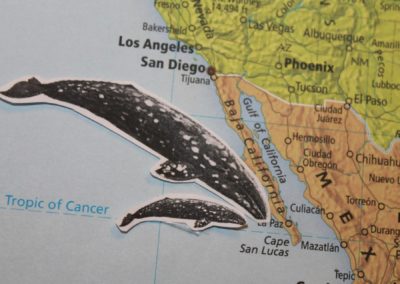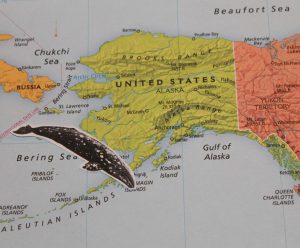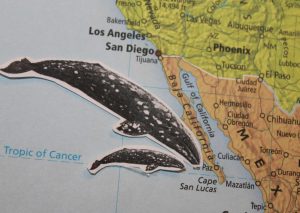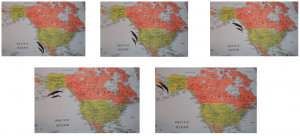
Gray Whales have the longest known migration of any mammal traveling a total of about 10,000 to 14,000 miles! This migration typically starts in the Bering, Chukchi, and Beuafort Seas and ends around the coast of Baja California. This massive migration is quite the feat and it typically takes two to three month just to travel one way! This means that gray whales spend almost half a year solely dedicated to their migration. So why do these massive marine mammals migrate so far? Proper food and breeding grounds are extremely important for the survival of Gray Whales. Therefore these two factors are driving forces behind such a large migration.
 Gray Whales typically spend their summers in the cold, nutrient rich waters of the north, in particular the Bering, Chuckchi, and Beuafort Seas, where they can find ample amounts of food. They have around 130 to 180 plates of baleen on each side of their upper jaw and utilize this baleen in order to catch their food. Gray Whales have developed the nickname “mudsuckers” over the years due to the fact that they love to eat invertebrates found on the muddy and sandy ocean floor. They will typically feed on just one side of their mouth making the either right sided or left sided feeders; kind of like how us humans are either righties or lefties. While feeding they utilize their baleen to filter out water and sediment while keeping the delicious benthic invertebrates trapped in their mouth.
Gray Whales typically spend their summers in the cold, nutrient rich waters of the north, in particular the Bering, Chuckchi, and Beuafort Seas, where they can find ample amounts of food. They have around 130 to 180 plates of baleen on each side of their upper jaw and utilize this baleen in order to catch their food. Gray Whales have developed the nickname “mudsuckers” over the years due to the fact that they love to eat invertebrates found on the muddy and sandy ocean floor. They will typically feed on just one side of their mouth making the either right sided or left sided feeders; kind of like how us humans are either righties or lefties. While feeding they utilize their baleen to filter out water and sediment while keeping the delicious benthic invertebrates trapped in their mouth.
Gray Whales start migrating south during the beginning of September and October and will start arriving in Baja by mid February and March.


Once in Baja they will begin to mate and calve a new generation of whales. The warm waters of Baja provide a safe environment for the mothers to nurse their calves. In the first few months of their life gray whale calves willbe nursed milk that is about 53% fat; this milk is so fatty that is has a consistency similar to cottage cheese! During the two to three months spent in the warm water of Baja young gray whales grow stronger and build up an ample amount of blubber for the colder waters of the north.
The migration back to northern waters typically begins in late March and mid April. During this northern migration mothers will travel close to shore to keep their young safe from potential predators and dangerous water.

Written By: Alex Feltes
Sources
Gray Whale. National Audubon Society: Guide to Marine Mammals of the World. 2002.


